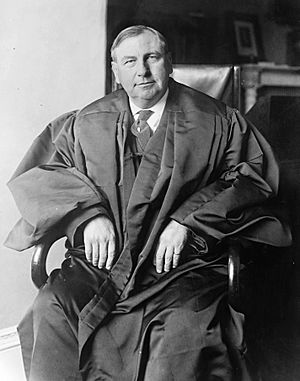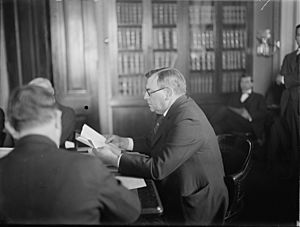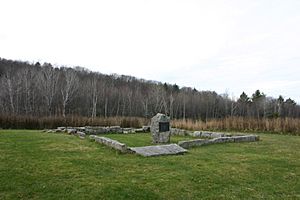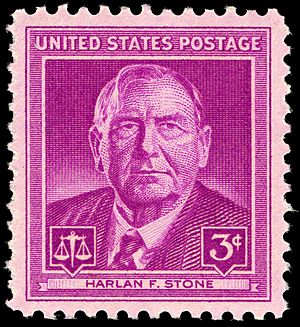Harlan F. Stone facts for kids
Quick facts for kids
Harlan F. Stone
|
|
|---|---|
 |
|
| 12th Chief Justice of the United States | |
| In office July 3, 1941 – April 22, 1946 |
|
| Nominated by | Franklin D. Roosevelt |
| Preceded by | Charles Evans Hughes |
| Succeeded by | Fred M. Vinson |
| Associate Justice of the Supreme Court of the United States | |
| In office March 2, 1925 – July 3, 1941 |
|
| Nominated by | Calvin Coolidge |
| Preceded by | Joseph McKenna |
| Succeeded by | Robert H. Jackson |
| 52nd United States Attorney General | |
| In office April 7, 1924 – March 1, 1925 |
|
| President | Calvin Coolidge |
| Preceded by | Harry M. Daugherty |
| Succeeded by | John C. Sargent |
| 4th Dean of Columbia Law School | |
| In office 1910–1923 |
|
| Preceded by | George Washington Kirchwey |
| Succeeded by | Young Berryman Smith |
| Personal details | |
| Born |
Harlan Fiske Stone
October 11, 1872 Chesterfield, New Hampshire, U.S. |
| Died | April 22, 1946 (aged 73) Washington, D.C., U.S. |
| Resting place | Rock Creek Cemetery |
| Political party | Republican |
| Spouse |
Agnes Harvey
(m. 1899) |
| Children |
|
| Education | Massachusetts Agricultural College (expelled) Amherst College (AB, AM) Columbia University (LLB) |
| Signature | |
Harlan Fiske Stone (October 11, 1872 – April 22, 1946) was an important American lawyer and judge. He served on the U.S. Supreme Court for many years. From 1925 to 1941, he was an associate justice. Then, from 1941 until he passed away in 1946, he became the 12th Chief Justice of the United States.
Before joining the Supreme Court, Stone was the U.S. Attorney General from 1924 to 1925. He worked under President Calvin Coolidge, who he knew from college. Stone was known for saying, "Courts are not the only agency of government that must be assumed to have capacity to govern." This meant that other parts of the government also have important roles in leading the country.
Stone grew up in Western Massachusetts. After studying law at Columbia Law School, he became a lawyer in New York City. He even became the Dean of Columbia Law School. During World War I, he helped decide if people who didn't want to fight in the war were truly against it for moral reasons. In 1924, President Coolidge asked Stone to be the Attorney General. Stone worked to improve the U.S. Department of Justice after some problems had occurred. He also took legal action against large companies to prevent them from becoming too powerful.
In 1925, Stone was chosen to join the Supreme Court. He believed that judges should respect the laws made by lawmakers. Later, on the Supreme Court, he was part of a group called the "Three Musketeers." This group supported President Franklin D. Roosevelt's "New Deal" programs, which aimed to help the country during tough economic times.
In 1941, President Roosevelt nominated Stone to become Chief Justice. The Senate quickly approved him. As Chief Justice, Stone led the Court during World War II. He made important decisions, including one that allowed military courts to try German spies. He served as Chief Justice until his death in 1946. He had one of the shortest terms as Chief Justice. He was also the first Chief Justice who had never been elected to a political office.
Contents
Early Life and Education
Harlan Fiske Stone was born in Chesterfield, New Hampshire, on October 11, 1872. When he was two years old, his family moved to western Massachusetts, where he grew up. He finished high school in Amherst.
His father wanted him to be a farmer who used science. Stone went to Massachusetts Agricultural College. However, he was asked to leave in his second year after a fight with a teacher. He then went to Amherst College and graduated with honors in 1894.
After college, Stone taught physics and chemistry at Newburyport High School in Massachusetts. He also taught history at Adelphi Academy in Brooklyn.
Starting a Legal Career
Stone studied at Columbia Law School from 1895 to 1898. He earned his law degree and became a lawyer in New York in 1898. He worked at law firms in New York City, including Sullivan & Cromwell.
From 1899 to 1905, he taught law at Columbia Law School. He then became the dean, or head, of the law school from 1910 to 1923.
During World War I, Stone helped review cases of men who refused to fight because of their beliefs. These were called conscientious objectors. He had to decide if their reasons were truly sincere. Stone believed that most citizens should support the country's efforts. However, he also recognized the bravery it took for someone to stick to their beliefs as a conscientious objector.
After the war, Stone spoke out against the Attorney General at the time. He disagreed with how the government was trying to remove immigrants without allowing them a fair court process. He also supported free speech for professors and other thinkers.
In 1923, Stone left his job as dean. He joined a well-known law firm on Wall Street, Sullivan & Cromwell. He earned a much higher salary there.
Serving as Attorney General
On April 1, 1924, President Calvin Coolidge chose Stone to be the United States Attorney General. President Coolidge picked Stone because he was seen as a very honest person. This was important because there had been some problems in the government during the previous president's time.
One of Stone's first actions was to remove officials who were not doing a good job. He replaced them with honest people. As Attorney General, he also appointed J. Edgar Hoover to lead the Bureau of Investigation. This agency later became the Federal Bureau of Investigation (FBI). Stone wanted the agency to be very efficient and effective.
Stone was an active Attorney General. He argued many of his department's cases in court. He also started an investigation into a large company called the Aluminum Company of America. This company was owned by the family of Andrew Mellon, who was the Secretary of the Treasury at the time.
In the 1924 presidential election, Stone supported President Coolidge. He was especially against a candidate who wanted Congress to be able to overrule Supreme Court decisions. Stone felt this would harm the independence of the courts.
Becoming a Supreme Court Justice

Soon after the 1924 election, a Supreme Court Justice retired. On January 5, 1925, President Coolidge nominated Stone to take his place as an associate justice. Most people approved of his nomination.
Some senators wondered if Stone's past work on Wall Street meant he would favor big businesses. To address these concerns, Stone offered to answer questions from the Senate Judiciary Committee in person. This was the first time a Supreme Court nominee had ever testified before the Senate.
After his testimony, the Senate approved Stone's nomination on February 5, 1925. He officially became an associate justice on March 2, 1925. He was the only Supreme Court justice appointed by President Coolidge.
In the 1920s, the Supreme Court often dealt with how businesses and the government should interact. Many justices believed businesses should be free from most government rules. Stone, however, often disagreed with this view. He joined other justices who believed that judges should respect the laws passed by elected lawmakers. This idea is called "judicial restraint."
From 1932 to 1937, Stone and two other justices, Louis Brandeis and Benjamin N. Cardozo, were known as the "Three Musketeers." They were seen as the more liberal group on the Court. They strongly supported President Franklin D. Roosevelt's "New Deal" programs. These programs aimed to help the country recover from the Great Depression. Stone wrote important opinions that helped shape how courts would review laws in the future.
Leading the Supreme Court
Stone's support for the New Deal made President Roosevelt favor him. On June 12, 1941, President Roosevelt nominated Stone to become the Chief Justice of the United States. The previous Chief Justice, Charles Evans Hughes, had even suggested Stone as his replacement. The Senate quickly approved Stone, and he became Chief Justice on July 3, 1941. He held this position until he died.
As Chief Justice, Stone wrote the Court's opinion in a famous case during World War II. This case, Ex parte Quirin, upheld the President's power to try German spies captured in America using military courts.
Stone also wrote an important opinion in the case of International Shoe Co. v. Washington (1945). This decision helped set the rules for when a state court can have power over people or companies from other states.
Stone was the fourth Chief Justice who had first served as an Associate Justice. He is also the only justice to have held every position on the Court, from the newest associate justice to the most senior, and then to Chief Justice.
Stone passed away suddenly on April 22, 1946, while he was in an open session of the Supreme Court. He had just finished reading his opinion in a case. He died at his home in Washington, D.C.
Legacy and Honors
Harlan F. Stone is buried at Rock Creek Cemetery in Washington, D.C.. His grave is near other important justices.
Stone was involved in many organizations. He was a director for a railroad company and president of the Association of American Law Schools. He was also a member of the American Bar Association.
He received many honorary degrees from colleges like Amherst, Yale, Columbia, and Williams. Amherst College later named Stone Hall in his honor.
Today, Columbia Law School gives out Harlan Fiske Stone Scholarships to students who show excellent academic performance. Yale Law School also awards the Harlan Fiske Stone Prize to winners of a moot court competition, which is like a practice court trial.
Family Life
Harlan F. Stone married Agnes E. Harvey in 1899. They had two children, Lauson H. Stone and the famous mathematician Marshall H. Stone. His brother was Winthrop Stone, who was president of Purdue University.
See also
- Demographics of the Supreme Court of the United States
- List of justices of the Supreme Court of the United States
- List of United States Supreme Court justices by time in office
- List of law clerks of the Supreme Court of the United States (Chief Justice)
- List of law clerks of the Supreme Court of the United States (Seat 9)
- United States Supreme Court cases during the Stone Court
- Justice Harlan Fiske Stone Bridge



